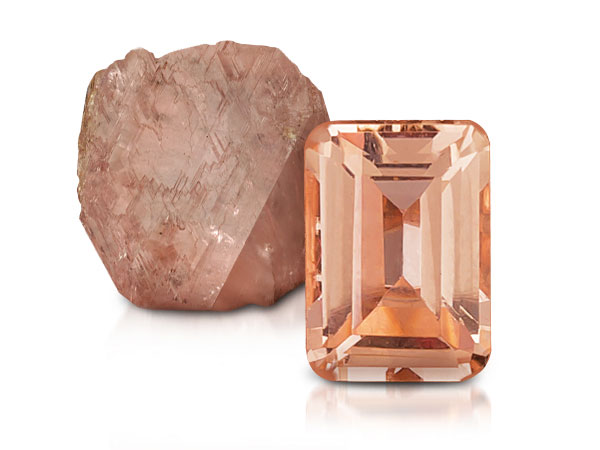PEACH MORGANITETM
Morganite, the sister stone of emerald and aquamarine, was first discovered in California and is named for J.P. Morgan, one of the greatest financiers in history and one of the most important gem collectors in the early 1900s. Originally known as pink beryl, this peachy pink gem which is rarer than aquamarine, receives its blush hue through traces of manganese. Stronger colors are possible, although the finest colors are mainly achieved through larger stones. Morganite crystals can be quite large, with stones in Brazil weighing over 22 pounds. The largest Morganite weighing in at 50 pounds was uncovered in the U.S. in 1989 and named "The Rose of Maine." The largest faceted Morganite is a 598.70-carat cushion-shape from Madagascar in the collection of the British Museum. Symbolically, Morganite is thought to induce peace, joy and inner strength.

PASSION FRUIT TOURMALINETM
Tourmaline as a gem has been around for centuries but until modern mineralogy, the dazzling colors of tourmaline were identified as another gem based on its coloring. Even the name given this gem, tourmaline, which comes from the Sri Lanka Sinhalese word "tura malli" meaning "mixed gems", identifies the confusion that surrounded the early days of this gem. Tourmaline is found in a rainbow of colors and various shades of each color - one of the widest color ranges found of any gem species. While all tourmaline colors share the same crystal structure, each color has its own set of complex elements that attribute to the color. In pink and red tourmaline, it is manganese.
Pink Tourmaline in History: In the early 1900s tons of tourmaline were exported from Southern California to China to satisfy the Empress Dowager Tz'u His's craving for pink tourmaline, her favorite gemstone.

Nude Diamonds™
Light Brown Diamonds, C2-C3 | Natural Color Diamond | Mohs Scale: 10 | April Birthstone | 10th Anniversary Gemstone
Nude Diamonds™ are more neutral than white diamonds; their natural hue complements all skin tones.”
Nude Diamonds™ are neutral skin tone, natural color diamonds that look colorless, take a high polish and offer a great value that is a fraction of the price of white diamonds. Le Vian® utilizes a very stringent selection process, choosing from a select range of high clarity natural faint and light brown diamonds with a touch of blush, the top of production, that are C2-C3 in color and SI or VS in clarity.






































